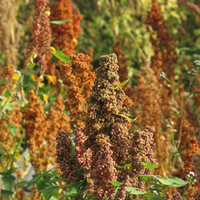Nitrogen, phosphorus and potassium mass balances in an irrigated quinoa field

Accepted: 20 February 2021
HTML: 54
All claims expressed in this article are solely those of the authors and do not necessarily represent those of their affiliated organizations, or those of the publisher, the editors and the reviewers. Any product that may be evaluated in this article or claim that may be made by its manufacturer is not guaranteed or endorsed by the publisher.
Sub-Saharan Africa (SSA) needs to increase food productivity to alleviate food insecurity exacerbated by climate variability and increasing food demand. Balancing macronutrient inputs is essential for sustaining yields, increasing farmer’s income and minimizing environmental costs deriving from fertilizer misuse. The present study calculates the nitrogen (N), phosphorus (P) and potassium (K) mass balances and estimates macronutrient inputs and outputs of a quinoa field cultivated under full and deficit irrigation conditions (100 and 50% crop evapotranspiration - ETc), in either the presence or absence of N fertilizer (100 and 0 kg ha–1 of N). The emerging findings show that to produce one ton of quinoa biomass (including seeds, stems and leaves) 12.7, 1.6 and 35.5 kg ha–1 of N, P and K, respectively, need to be added into the soil. While N and K are required at medium to fairly high amounts, P is needed in lower amounts. Hence, fertilizers in the form of potassium nitrate (KNO3) are more suitable than those with higher phosphorus concentrations, for example phosphate (PO43–). Overall, evidences from field experimentations are necessary for integrating farming input recommendations on crop agronomic guidelines, driven by national agricultural research institutions, and for promoting sustainable agriculture in SSA.
Highlights
- 12.7, 1.6 and 35.5 kg ha–1 of N, P and K, respectively, are required to produce 1 ton of quinoa biomass.
- Seed yields of 1380 kg ha–1 can be attainded under full irrigation and 100 kg ha–1 of N.
- MAPE values of –7.5, +4.3 and +3.3 between N, P, K mass balance calculations and observed values in the field.
How to Cite

This work is licensed under a Creative Commons Attribution-NonCommercial 4.0 International License.
PAGEPress has chosen to apply the Creative Commons Attribution NonCommercial 4.0 International License (CC BY-NC 4.0) to all manuscripts to be published.

 https://doi.org/10.4081/ija.2021.1788
https://doi.org/10.4081/ija.2021.1788







